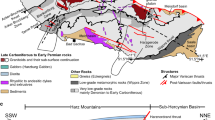Abstract
The Ardara pluton as part of the Donegal batholith was intruded into Neoproterozoic metasediments and metadolerites at mid-crustal levels. The emplacement mechanism of the Ardara granite is very controversial, and mechanisms ranging from diapirism, ballooning and stoping followed by nested diapirism have been proposed. Magnetic fabrics, rock fabrics and K/Ar dating of micas are used here to constrain the emplacement history. The compositional zoning of the Ardara pluton is clearly reflected in the different bulk magnetic susceptibilities between the outer quartz monzodiorite and the central granodiorite, whereas the intervening tonalite is of intermediate nature. The magnetic carriers are characterized by the anisotropy of the magnetic susceptibility (AMS), thermomagnetic measurements and through high field analyses (HFA). The separation of the ferrimagnetic and paramagnetic contributions revealed that biotite and magnetite control the AMS in the quartz monzodiorite. Both minerals are oriented in such a way that their summed contribution is constructive and originates from the shape fabric of magnetite and the texture of biotite. Biotite is responsible mainly for the AMS in the tonalite and granodiorite. The magnetic foliation can be directly related to the macroscopic foliation and also to the D4 structures in the country rocks. The foliation is consistent with the geometry of the roughly circular shape and has a mostly steep to vertical dip. Towards the central granodiorite the magnetic foliation dies out, although plagioclase texture measurements indicate a weak magmatic shape fabric. With the exception of the tail, the Kmax axes (magnetic lineation) vary from steeply to gently plunging. The so-called lineation factor is approximately 1.01 and therefore points to a less significant axial symmetry. These observations coincide with strain estimates on mafic enclaves that show a very consistent pattern of K ∼0 flattening strain. Texture analyses of biotite and quartz additionally support the observations made by the strain analyses and the magnetic fabric data. Microstructural investigations give evidence that the fabrics are associated with the emplacement over a range of temperatures from truly magmatic to high-temperature solid-state conditions. The age of the intrusion is still under discussion, but a new cooling age was determined by K/Ar dating of biotite at 403.7±8 Ma corresponding to a temperature range between 450 and 300°C. For a mylonite along the southern contact between the Ardara pluton and the country rock a K/Ar muscovite age of 378.8±7 Ma indicates a minimum age for the shear zone when the Ardara pluton must have already been cooled down below 350±50°C.
Similar content being viewed by others
Author information
Authors and Affiliations
Additional information
Received: 28 January 1999 / Accepted: 28 December 1999
Rights and permissions
About this article
Cite this article
Siegesmund, S., Becker, J. Emplacement of the Ardara pluton (Ireland): new constraints from magnetic fabrics, rock fabrics and age dating. Int Journ Earth Sciences 89, 307–327 (2000). https://doi.org/10.1007/s005310000088
Issue Date:
DOI: https://doi.org/10.1007/s005310000088




